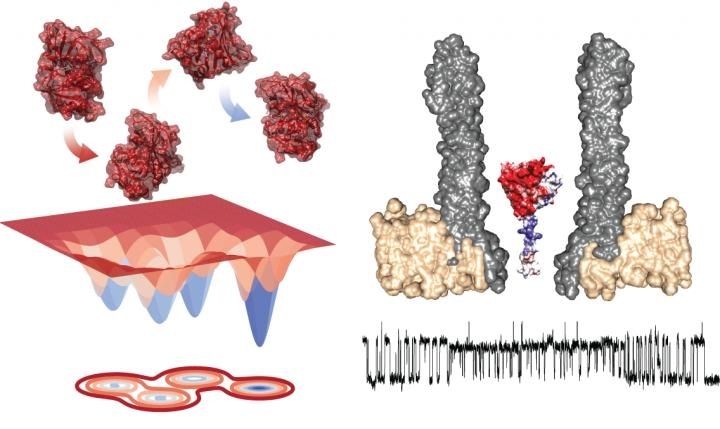Researchers from the University of Groningen have visualized the characteristics of a single enzyme within a nanopore.
The study shows that the enzyme can occur in four distinct folded states, or conformers, that play a key role in the reaction mechanism.

Energy diagram of the four conformers (left) and the experimental setup showing the nanopore with the trapped enzyme in cross section (right). Underneath, there is a typical trace showing measurements during exchange within rotamers. Image Credit: Giovanni Maglia, University of Groningen.
The outcomes of the study, which was published in Nature Chemistry on April 6th, will have implications for the development of inhibitors and enzyme engineering.
Enzymes can be described as folded proteins with a unique 3D structure that produces an active site that binds a substrate and catalyzes a particular reaction.
Recently, it has become apparent that enzymes are not rigid structures but folded proteins occur as an ensemble of conformations in equilibrium in an energetically stable ground state.
Wind tunnel
Single enzymes should be observed for a longer time to study the transition between states. This is highly challenging. Giovanni Maglia, an associate professor of chemical biology at the University of Groningen, developed funnel-shaped nanopores with the ability to trap proteins.
Maglia could observe the conformational changes in enzymes by measuring the ionic current across a nanopore, integrated into an artificial lipid membrane.
You could compare it with studying a car in a wind tunnel. Opening a window or a door will change the airflow. In a similar way, a change in the folding structure of the enzyme changes the ionic current through the pore.”
Giovanni Maglia, Associate Professor of Chemical Biology, University of Groningen
Using the nanopore system, Maglia analyzed the enzyme dihydrofolate reductase (DHFR), which transforms dihydrofolate into tetrahydrofolate.
We chose this enzyme because it has been studied as a model system for enzyme dynamics for over thirty years, using all available techniques. In addition, inhibitors of this enzyme, such as methotrexate, are used as anti-cancer drugs.”
Giovanni Maglia, Associate Professor of Chemical Biology, University of Groningen
Efficient release
Measurements of DHFR demonstrated the existence of four different conformers, with different affinities for the substrates. Maglia added, “Switching between these four states was very slow. This means that you can only see them in these kinds of long-lasting single enzyme studies.”
Upon adding the reaction inhibitor methotrexate that binds to the enzyme, there was a very fast transition between states and a change in the affinity of the enzymes. “Our conclusion is that the reactions of the enzyme with different compounds provide the free energy for conformational changes,” stated Maglia.
Moreover, conformational changes also altered the affinity of the enzymes. This is meaningful since the enzyme should bind to two substrates and must release both of them once the reaction is complete.
According to Maglia, “The substrate and the product are very similar molecules, so the enzyme needs to change its affinity for an efficient release.”
Two states
From the studies, Maglia can observe the transition of enzyme between two states—once it binds to the substrate, NADPH triggers the reaction and causes a conformational change of the enzyme and also its affinity.
Subsequently, when a new substrate binds to it, it returns to the original state. Maglia adds, “This explains two of the four conformers that we observed; we cannot yet make sense of the other two.” It is not feasible to extract structural information from the measurements. However, the study demonstrates the power of nanopore technology to determine the structural variations of enzymes.
We also now know that this enzyme has four different ground states and must switch between them to function. This may explain why artificially designed enzymes often do not work as efficiently as natural enzymes.”
Giovanni Maglia, Associate Professor, Department of Chemical Biology, University of Groningen
This makes enzyme designing more challenging: apart from producing a reactive center, it should also allow the essential conformational changes. Eventually, the study will also enable researchers to identify new inhibiting drugs that bind to DHFR tighter than methotrexate.
Source:
Journal reference:
Galenkamp, N. S., et al. (2020) Directional conformer exchange in dihydrofolate reductase revealed by single-molecule nanopore recordings. Nature Chemistry. doi.org/10.1038/s41557-020-0437-0.